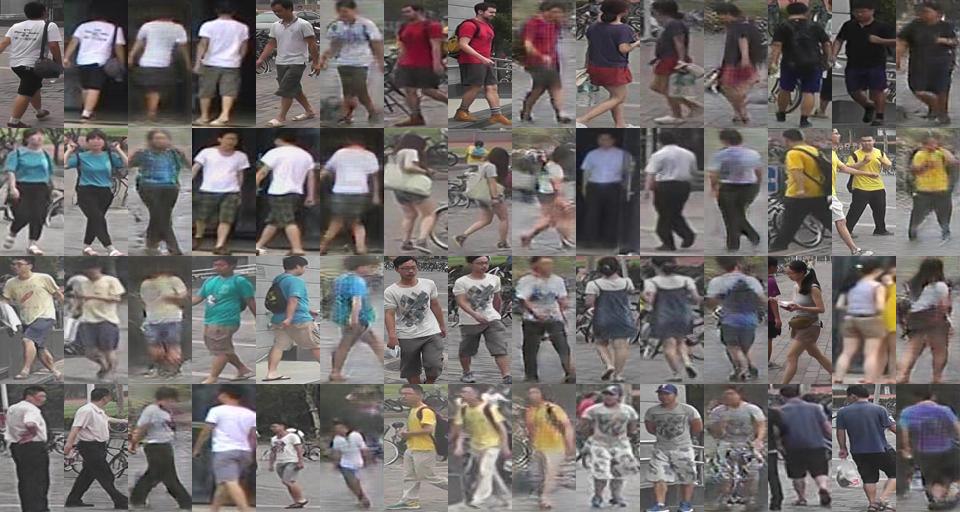Human Pose Transfer
Implemented paper
- Pose Guided Person Image Generation (NIPS2017)
- Disentangled Person Image Generation (CVPR2018 Spotlight)
- Progressive Pose Attention Transfer for Person Image Generation (CVPR2019 Oral)
- Pose-normalized image generation for person re-identification
Prepare
Requirement
- PyTorch 1.1+(if you use Pytorch 1.0,
tensorboardXis also needed.) - ignite
- torchvision
- TensorBoard
- numpy
- tqdm
DataSet
For fair comparison, all implementation use 263,632 training pairs and 12,000 testing pairs from Market-1501 as in PATN
| description | download from |
|---|---|
| Market1501 dataset images | Market1501 |
train/test splits market-pairs-train.csv, market-pairs-test.csv |
Pose-Transfer |
train/test key points annotations market-annotation-train.csv, market-annotation-train.csv |
Pose-Transfer |
| Attribute of images not necessary for now | Market-1501_Attribute |
copy&rename above pair and annotation file to ./data
Finally, your ./data folder looks like:
data
├── market
│ ├── annotation-test.csv
│ ├── annotation-train.csv
│ ├── pairs-test.csv
│ ├── pairs-train.csv
│ ├── attribute
│ │ ├── evaluate_market_attribute.m
│ │ ├── gallery_market.mat
│ │ ├── market_attribute.mat
│ │ ├── README.md
│ │ └── sample_image.jpg
│ ├── test # WILL BE GENERATED IN NEXT STEP
│ │ ├── pose_map_image
│ │ └── pose_mask_image
│ └── train # WILL BE GENERATED IN NEXT STEP
│ ├── pose_map_image
│ └── pose_mask_image
Generate Pose 18-channels image and corresponding mask
python3 tool/generate_pose_map_add_mask.py --type trainpython3 tool/generate_pose_map_add_mask.py --type test
Train & Test
Obviously, there is a lot of duplicate code between different implementations.
In order to avoid repeating myself, I introduced a concept called engine.
Whether it is training or testing, it can be seen as an engine, and some repetitive tasks
(like loading config, preparing GPU) are done in the run.py.
run.py is the start point to train or test.
the usage of run.py:
$./run.py -h
usage: Train [-h] -g GPU_ID -c CONFIG -o OUTPUT [-t TOML]
{PG2-1,PG2-2,PG2-Generator}
positional arguments:
{PG2-1,PG2-2,PG2-Generator}
run which?
optional arguments:
-h, --help show this help message and exit
-g GPU_ID, --gpu_id GPU_ID
gpu_id: e.g. 0
-c CONFIG, --config CONFIG
config file path
-o OUTPUT, --output OUTPUT
output path
-t TOML, --toml TOML overwrite toml config use cli argDuring training, you can inspect log/generated_images/model_weights with tensorboard:
# tensorboard --logdir </path/to/checkpoint> --port <port>
tensorboard --logdir ./checkpoints/PG2-1 --port 8000example
# ./run.py <engine_name> -g <gpu_id> -c </path/to/config> -o </path/to/checkpoint>
# start to train PG2 stage1.
./run.py PG2-1 -g 1 -c ./implementations/PG2/stage1.toml -o ./checkpoints/PG2-1
# the way to generated images
./run.py PG2-Generator -g 1 -c ./implementations/PG2/stage2.toml -o ./generated_images/PG2I use TOML as the config format, and you can overwrite the config file with cli arg like this:
./run.py PG2-1 -g 1 -c ./implementations/PG2/stage1.toml -o ./checkpoints/PG2-1 \
-t "loss.mask_l1.weight=20" -t "train.data.replacement=true"So, if you wang to specified generated images amount(default: full/12000), you can add a option: -t "generated_limit=100"
the full command example:
./run.py PG2-Generator -g 1 -c ./implementations/PG2/stage2.toml -t "generated_limit=100" -t "model.generator1.pretrained_path='./checkpoint/PG2-1/network_G1_26000.pth'" -t "model.generator2.pretrained_path='./checkpoint/PG2-2_26000/network_G2_13000.pth'" -o generated_imagesImplement result
PG2
First, please change dataset.path.train.image in ./implementations/PG2/stage[1|2].toml
train stage 1: ./run.py PG2-1 --gpu_id 0 -c ./implementations/PG2/stage1.toml -o ./checkpoints/PG2-1
train stage 2: ./run.py PG2-2 -g 2 -c ./implementations/PG2/stage2.toml -o ./checkpoints/PG2-2
generate images: ./run.py PG2-Generator -c ./implementations/PG2/stage2.toml -o ./generated_images -g 3
generate a grid image as example: python tool/generate_grid.py -r ./generated_images -o images.jpg
Pre-trained model
Please note that this is NOT the best result, the result is just not bad. it can not be used in academic papers.
Pre-trained model can be downloaded Google Drive or Baidu Disk 提取码(code): n9nj
I also provided the tensorboard log file.
# download&extract files above.
unzip weights.zip
# generate all test images
./run.py PG2-Generator -c ./implementations/PG2/stage2.toml -o ./generated_images -g 3 -t "model.generator1.pretrained_path='path/to/weights/G1.pth'" -t "model.generator2.pretrained_path='path/to/weights/G2.pth'"
# random select some images to display
`python tool/generate_grid.py -r ./generated_images -o images.jpg`
# see training logs and images.
tensorboard --logdir path/to/weights/train2 --port 8080Evaluate
For fair comparisons, I just copy&use the same evaluation codes in previous works, like Deform, PG2 and PATN.
I recommend using docker to evaluate the result
because evaluation codes use some outdated frameworks(Tensorflow 1.4.1).
So, next:
- build docker image with
./evaluate/Dockerfile - run evaluate script
$ cd evaluate
$ docker build -t hpt_evaluate .
$ # For user in China, you can build docker image like this:
$ docker build -t hpt_evaluate . --build-arg PIP_PYPI="https://pypi.tuna.tsinghua.edu.cn/simple"
$ cd ..
$ docker run -v $(pwd):/tmp -e NVIDIA_VISIBLE_DEVICES=0 -w /tmp --runtime=nvidia -it --rm hpt_evaluate:latest python evaluate/getMetrics_market.pyOr use image tensorflow/tensorflow:1.4.1-gpu-py3 to evaluate in docker bash:
docker run -v $(pwd):/tmp -w /tmp --runtime=nvidia -it --rm tensorflow/tensorflow:1.4.1-gpu-py3 bash
# now in docker:
$ pip install scikit-image tqdm
$ python evaluate/getMetrics_market.py
Thanks
Liqian Ma - PG2's Tensorflow implementation Thanks for his patience. ( ̄▽ ̄)"
@tengteng95 - Pose-Transfer for clear code structure and his great paper.
